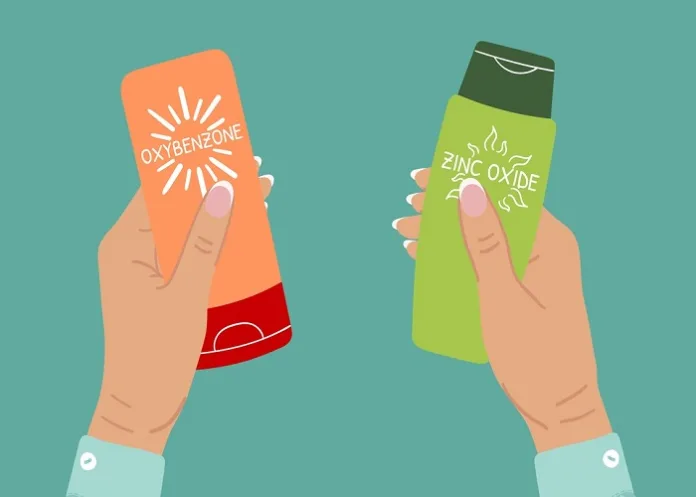Despite warnings and safely concerns expressed by the US Food and Drug Administration (FDA) four years ago about dangerous ingredients in sunscreens, some of them – especially the carcinogenic oxybenzone – are still found in some products on the shelves.
In 2019, the FDA told sunscreen manufacturers it was worried about 12 ingredients that give so-called chemical lotions and sprays their protective power, the main one being oxybenzone.
It can upset the balance of hormones in ways that may increase cancer risk and lead to shorter pregnancies as well as lower testosterone levels in adolescent boys, studies have shown. Oxybenzone has been found in amniotic fluid and breast milk, reports Bloomberg News.
While oxybenzone has been largely eliminated as an ingredient – although manufacturers typically cannot get to a sun protection factor above 50 without adding it to the mix – it can still be found in popular brands.
The percentage of chemical sunscreens with oxybenzone on the market fell from 60% in 2019 to 13% this year, said the Environmental Working Group, a research and advocacy organisation in Washington.
But that drop has been driven more by consumer sentiment than official action: the FDA hasn’t ordered the removal of oxybenzone from sunscreens or assured the public that it is safe.
At the time, the agency said that without more data it couldn’t continue to let the ingredients be included in sunscreens. But the industry, led by lobbying group the Personal Care Products Council, asked the FDA to wait; the council said it would get the FDA more information by this year.
That hasn’t happened. “We still have not seen any data submissions or plans for data submissions,” said Homer Swei, senior vice-president for healthy living science at the Environmental Working Group.
Oxybenzone and other ingredients in question, like homosalate and avobenzone, are known as endocrine disrupters.
The National Institute of Environmental Health Sciences has linked endocrine disrupters to attention-deficit/hyperactivity disorder in addition to the cancer and fertility issues. In the US, sunscreen makers use homosalate in concentrations as high as 15%; in the EU, the limit is 0.5%.
The concerns aren’t limited to endocrine disrupters. Research published in 2021 found that some sunscreens with the popular ingredient octocrylene tested positive for benzophenone, a possible carcinogen that can form when octocrylene breaks down over time.
German chemical manufacturer BASF told sunscreen makers that year it would stop supplying octocrylene after “listening to the growing concerns” about it. The company stopped fulfilling orders in December 2022, according to a letter obtained by Bloomberg News.
The FDA doesn’t want to discourage people from using sunscreen. “Given the recognised public-health benefits,” the spokesperson says, “the FDA is committed to finding ways to facilitate the marketing of sunscreen products.”
But the agency also hasn’t approved newer, alternative ingredients. It considers sunscreens over-the-counter drugs, though when it began regulating their ingredients 40-plus years ago, it didn’t require companies to supply much data on the chemicals.
In 2020, the FDA published a study in the Journal of the American Medical Association that found sunscreen ingredients entered the bloodstream after just one use and can stay in our systems for as long as 21 days: oxybenzone and homosalate lasted the longest.
Safety concerns aside, the 12 ingredients the FDA has flagged mainly protect against ultraviolet B rays, which cause sunburn. In Europe, newer formulations also are better at boosting protection from UVA rays, which penetrate the skin and can cause cancer.
Avobenzone and the mineral zinc are considered the best ingredients now available for UVA protection in the US. The sunscreen industry has not yet produced the safety and effectiveness data the FDA requires for newer ingredients.
Alternatives
In the meantime, consumers are turning to mineral sunscreens, like zinc oxide and titanium dioxide, which block UVA and UVB rays.
Douglas Grossman, co-leader of the University of Utah Huntsman Cancer Institute’s Melanoma Centre, advised patients to use a mineral sunscreen. “It avoids all the issues with chemical sunscreens,” he says. “It just makes common sense that you put something on the skin and it blocks the UV, it’s going to work better than if you have something that absorbs into the skin and the UV penetrates the skin.”
With both chemical and mineral sunscreens, a sun protection factor above 30 doesn’t provide significantly greater protection.
Sun protection factor 30 blocks 97% of UVB rays, while 50 blocks 98%, and it takes higher concentrations of ingredients to reach higher sun protection factors. The FDA has proposed prohibiting sunscreen makers from selling products labelled with a sun protection factor higher than 60.
There’s Still Scary Stuff in Sunscreen (Restricted access)
See more from MedicalBrief archives:
Not enough safety data or research on sunscreen safety, say US scientists
FDA study finds sunscreen’s active ingredients readily absorbed in bloodstream
Sunscreen users get only 40% the sun protection they think

